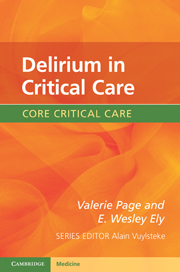Book contents
- Frontmatter
- Contents
- Foreword
- Delirium, a patient testimony
- 1 What is delirium in critical care?
- 2 How common is delirium in critical care?
- 3 What does delirium look like in critical care?
- 4 Delirium in critical care: how does it happen?
- 5 Delirium: what causes it? Risk factors
- 6 Delirium in critical care: why is it important?
- 7 Delirium in critical care: how do we diagnose it?
- 8 How to prevent delirium?
- 9 Treatment of delirium in critical care
- 10 Mental capacity and restraints
- 11 End-of-life care
- 12 What is the future?
- Selected references
- Index
- References
2 - How common is delirium in critical care?
Published online by Cambridge University Press: 05 December 2011
- Frontmatter
- Contents
- Foreword
- Delirium, a patient testimony
- 1 What is delirium in critical care?
- 2 How common is delirium in critical care?
- 3 What does delirium look like in critical care?
- 4 Delirium in critical care: how does it happen?
- 5 Delirium: what causes it? Risk factors
- 6 Delirium in critical care: why is it important?
- 7 Delirium in critical care: how do we diagnose it?
- 8 How to prevent delirium?
- 9 Treatment of delirium in critical care
- 10 Mental capacity and restraints
- 11 End-of-life care
- 12 What is the future?
- Selected references
- Index
- References
Summary
The number game
Delirium has a wide diversity of names and multiple possible causes (see Chapter 1). It can clinically be seen as stupor, agitation or both. Theories about its pathophysiology abound – and all of them may prove correct. The criteria used to diagnose delirium evolve continuously and the literature and research relating to delirium is dogged by ambiguity. As a result, the prevalence will depend on case mix, duration of screening and screening tool used.
The overall picture
It is known that overall 1:6 patients will be delirious in any general hospital ward, with the greatest incidence found in intensive care (1:5 in high dependency patients and around 4:5 in ventilated patients). Simply, the sicker you are the more likely you are to become delirious. This has led some clinicians to believe that delirium is merely a reflection of how critically ill the patient is rather than being of any importance in itself. But the evidence clearly demonstrates that delirium is associated with seriously adverse outcomes, independent of the severity of the patient's illness.
Different clinical areas will have a different number of patients affected; with an incidence of around 2:5 in an acute geriatrics ward, and 3:5 in patients who have suffered a fractured neck of femur.
This means that on any given day in an acute general hospital of around 1000 beds, there will be more than 100 delirious patients!
- Type
- Chapter
- Information
- Delirium in Critical Care , pp. 14 - 26Publisher: Cambridge University PressPrint publication year: 2011

